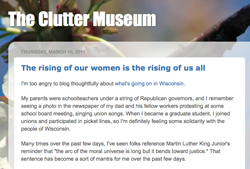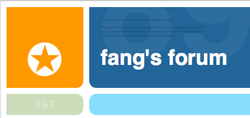There’s a green one and a pink one
And a blue one and a yellow one,
And they’re all made out of ticky tacky
And they all look just the same.
(Would it be heavy-handed to quote the next verse?)
I haven’t blogged for a while because the new job (director of instructional design and educational assessment), which I’ve been doing on top of being a history professor, has used up all my brain space. The position encompasses even more than I thought it would. (Anyone here ever been responsible for an online testing center before, or merged two testing centers into one? Me neither.) Toss in a mandate for electronic accessibility, a need to represent students’ achievement of university learning outcomes both quantitatively and qualitatively to accreditors, a small staff of bright people who are already pulled in too many directions, software the university adopted that may or may not work as advertised (but which I’m responsible for making sure gets used as it was marketed), an expectation we’ll find a way to lower course resource costs for students, a relationship to be (re)built with the campus’s rapidly expanding online learning unit, and much more. . . and I barely have time to think about anything else.
I really do enjoy the work because I get to think about big-picture things and have interesting conversations with all kinds of people, but it seems every day some issue emerges that causes me some cognitive dissonance or, at the very least, pedagogical discomfort.
Right now I’m stuck on the imperative to be “entrepreneurial” within the context of the university.
I’m torn. On the one hand, I’m all for finding new and interesting sources of funding—by which I mean grants and community partnerships—for scholarly and creative work that might otherwise be impossible. On the other hand, there’s a renewed attention to the bottom line that makes the humanist in me deeply uncomfortable. (I feel compelled to preemptively mention the History department is profitable; it brings in more money to the university than it costs, especially now that we are—to borrow terminology from those darling Silicon Valley start-ups—a leaner and therefore more agile unit.)
But, it ends up, there’s profitable and then there’s profitable. In the new cult of entrepreneurialism, the History department’s metrics make our entire endeavor—our research, courses, and public service—appear, in the eyes of some administrators, barely sustainable. When the provost came to talk to the History department, he recommended we spawn some “self-supporting” degrees or programs that would help to fund our bread-and-butter bachelor’s degree programs.
So, what is a self-supporting program? In my local context, a self-supporting program does not receive any funds appropriated from the state. (This is important because state appropriations to Idaho’s universities fell when the recession began, and have yet to return to 2008 levels. In addition, the state board of education provides Boise State only 2/3 the amount per student as it does the University of Idaho.) In return for not costing the university much, each self-supporting program (I’m told) gets to keep upwards of 90 percent of its revenue, out of which it pays faculty salaries and all its other costs.
There is a tremendous incentive in self-supporting programs, then, to reduce costs incurred by the department and to have students bear as many of these costs as possible.
As any academic knows, one way to reduce costs to the department is to hire very few tenure-line faculty and to farm out teaching to lecturers or, better yet, adjuncts. And there is a widespread belief—which I’m guessing is a myth—that online programs save the university money because they don’t place a burden on the university’s physical plant. In this paradigm, the most economical courses are those offered online and taught by adjuncts. (Of course, it’s not really economical, as there’s a huge support infrastructure in place—from servers and the people who maintain them, to expensive enterprise software and the people who maintain it, to instructional designers, help desk staff, admissions recruiters, the registrar, and all kinds of other units that don’t get reimbursed in any meaningful way by these self-supporting programs.)
But who has time to ensure all those online adjuncts are adhering to best practices in instructional design? A university can moderate such concerns by having “subject-matter experts”—who may or may not be tenure-line faculty—provide the content for each course. Then, in concert with specialists in instructional design, the subject-matter expert develops a course, populating, for example, discussion boards with prompts and exams with questions and answers. This course is then cloned within the university’s learning management system (e.g., Blackboard) and handed off to adjuncts whose teaching experience and subject matter expertise fall all over the spectrum. For purposes of quality control and discipline-specific accreditation (for example, in engineering or the health sciences), the adjuncts typically lack opportunities to make their course their own. The course becomes, for all intents and purposes, a less-than-open xMOOC with better-staffed sections.
On my least cynical, most optimistic days, I can see how this process might work for, say, Boise State’s nursing program, which offers a bachelor’s degree completion program for RNs, for a relatively cookie-cutter MBA program, or for any number of programs that offer continuing education to professionals in fields that require formal accreditations beyond degrees.
It’s going to be a screaming failure in the humanities, however. In some cases, the one thing humanities adjuncts have going for them is a sense of autonomy in designing their courses and agency in teaching them. This paradigm takes away that autonomy, in the name of cost-cutting and quality control. If you think humanities adjuncts are agitated now, wait until universities ask them to teach courses out of a box.
In addition, the humanities typically don’t scale well. Done well, the humanities require significant time for research, reflection, discernment, and revision. When he met with the History department, our provost recommended, for example, we bring in 30 new grad students each year and graduate 11 of them. (As I understand it, we typically bring in 10 students in a good year, and offer support to fewer than half those students. Eleven students is a lot. Because history student projects necessitate many, many drafts and we require a high standard of student work, I had three grad students file to graduate this spring, but only one did.) We have 14 tenure-line faculty in the department, and most of them don’t serve on more than two graduate students’ committees at any one time, but if we’re to keep our graduate programs, our tenure-line faculty are expected to ramp those numbers up considerably while teaching a 3/3 load, plus doing enough research to keep us off a 4/4 load.
Yes, there are examples of individual instructors teaching humanities concepts well online for a large audience of enrolled or open students—I’m thinking in particular of DS 106 in its various permutations—but in every case I can think of, their success relies on connectivism rather than content delivery, and they teach outside of a traditional LMS. The scale derives from an instructor’s generosity with his or her time, and from students’ willingness to expand their personal learning networks, rather than from a widgetizing of course production.
In a climate that favors entrepreneurialism and self-supporting programs, the problem is that the humanities—and increasingly so, when we teach them well—are about building community, about collaboration and connection—not about sharing content in a way that can be measured by exams. The learning management platforms on which universities offer online courses are optimized for sharing content and quizzing students on their knowledge of that content, not for genuine connection and community-building.
But back to the provost’s recommendation that the History department develop some self-supporting programs: what kind of student is going to pay premium rates for a humanities degree? Humanities degrees do indeed provide a significant financial return on their investment by mid-career but our students don’t usually understand that, focused as they are on getting that first post-baccalaureate job. In the cold calculus of universities with dwindling state support, the humanities may slip from being the bread-and-butter liberal arts courses at the heart of a quality undergraduate education, becoming instead a luxury for those who can afford higher tuition for History courses one administration here dubbed “boutique.”
Meanwhile, of course, employers are asking for students who can think critically and creatively, synthesize complex information from multiple sources, and write well. I can’t wait to see how universities get remote nursing or business adjuncts to teach those skills online.

